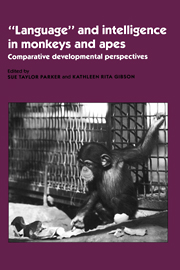Book contents
- Frontmatter
- Contents
- List of contributors
- Foreword
- Preface
- Acknowledgments
- Part I Theoretical frameworks for comparative developmental studies
- Part II Comparative developmental perspectives on cebus intelligence
- Part III Questions regarding imitation, “language,” and cultural transmission in apes and monkeys
- Part IV Developmental perspectives on social intelligence and communication in great apes
- 12 The emergence of intentional communication as a problem-solving strategy in the gorilla
- 13 “Social tool use” by free-ranging orangutans: A Piagetian and developmental perspective on the manipulation of an animate object
- 14 The development of peer social interaction in infant chimpanzees: Comparative social, Piagetian, and brain perspectives
- 15 Spatial expression of social relationships among captive Pan paniscus: Ontogenetic and phylogenetic implications
- Part V Development of numerical and classificatory abilities in chimpanzees and other vertebrates
- Part VI Comparative developmental perspectives on ape “language”
- Index
12 - The emergence of intentional communication as a problem-solving strategy in the gorilla
Published online by Cambridge University Press: 11 May 2010
- Frontmatter
- Contents
- List of contributors
- Foreword
- Preface
- Acknowledgments
- Part I Theoretical frameworks for comparative developmental studies
- Part II Comparative developmental perspectives on cebus intelligence
- Part III Questions regarding imitation, “language,” and cultural transmission in apes and monkeys
- Part IV Developmental perspectives on social intelligence and communication in great apes
- 12 The emergence of intentional communication as a problem-solving strategy in the gorilla
- 13 “Social tool use” by free-ranging orangutans: A Piagetian and developmental perspective on the manipulation of an animate object
- 14 The development of peer social interaction in infant chimpanzees: Comparative social, Piagetian, and brain perspectives
- 15 Spatial expression of social relationships among captive Pan paniscus: Ontogenetic and phylogenetic implications
- Part V Development of numerical and classificatory abilities in chimpanzees and other vertebrates
- Part VI Comparative developmental perspectives on ape “language”
- Index
Summary
Introduction
Since Wolfgang Köhler carried out his pioneering experiments on the intelligence of apes (Köhler, 1917), investigators have commonly tested the intelligence of anthropoids by confronting animals with situations in which a desirable goal is not directly available. The animal's task is to find an indirect way to get to the goal. In the simplest case, the solution consists of approaching the goal through a detour pathway; in more complex cases, the ape must use a tool to reach the goal (e.g., a box is placed under a goal hanging from the ceiling, or a stick is used to obtain an out-of-reach object) (Bingham, 1929; Guillaume & Meyerson, 1930; Köhler, 1917; Yerkes, 1927). Apes are able to solve these problems with remarkable efficiency, demonstrating, from a human Piagetian perspective, higher levels of sensorimotor or practical intelligence (Piaget, 1936).
Typically, in these experiments, the investigator keeps the animal isolated in the cage while the human observers watch from outside. Köhler's original experiments, however, did not actually conform to this arrangement. In many (if not most) experimental situations, Köhler himself and/or other humans were inside the animals' rooms, without any barrier separating them from their anthropoid subjects. This design allowed Köhler to observe what he considered “a most remarkable procedure” of problem solving. After failing to produce the orthodox solution (pushing a box) in the classical problem of the goal hanging from the ceiling, one of Köhler's chimpanzees developed the habit of approaching the human observer, taking him by the hand, and bringing him under the goal, where the animal would try to reach the goal by climbing on the observer.
Information
- Type
- Chapter
- Information
- 'Language' and Intelligence in Monkeys and ApesComparative Developmental Perspectives, pp. 333 - 355Publisher: Cambridge University PressPrint publication year: 1990
Accessibility standard: Unknown
Why this information is here
This section outlines the accessibility features of this content - including support for screen readers, full keyboard navigation and high-contrast display options. This may not be relevant for you.Accessibility Information
- 37
- Cited by
